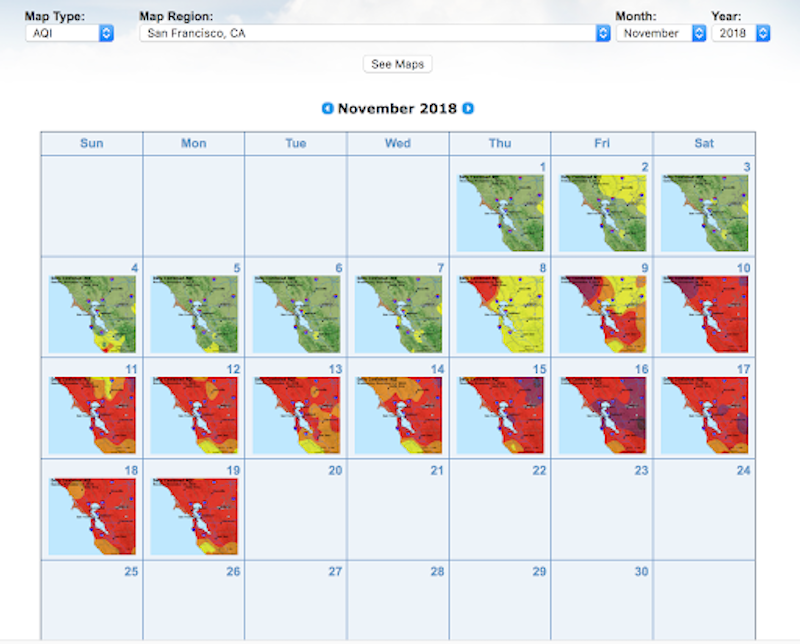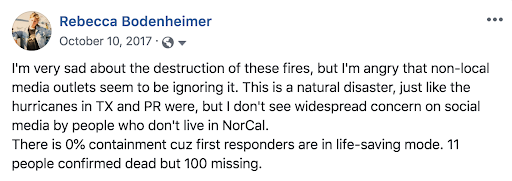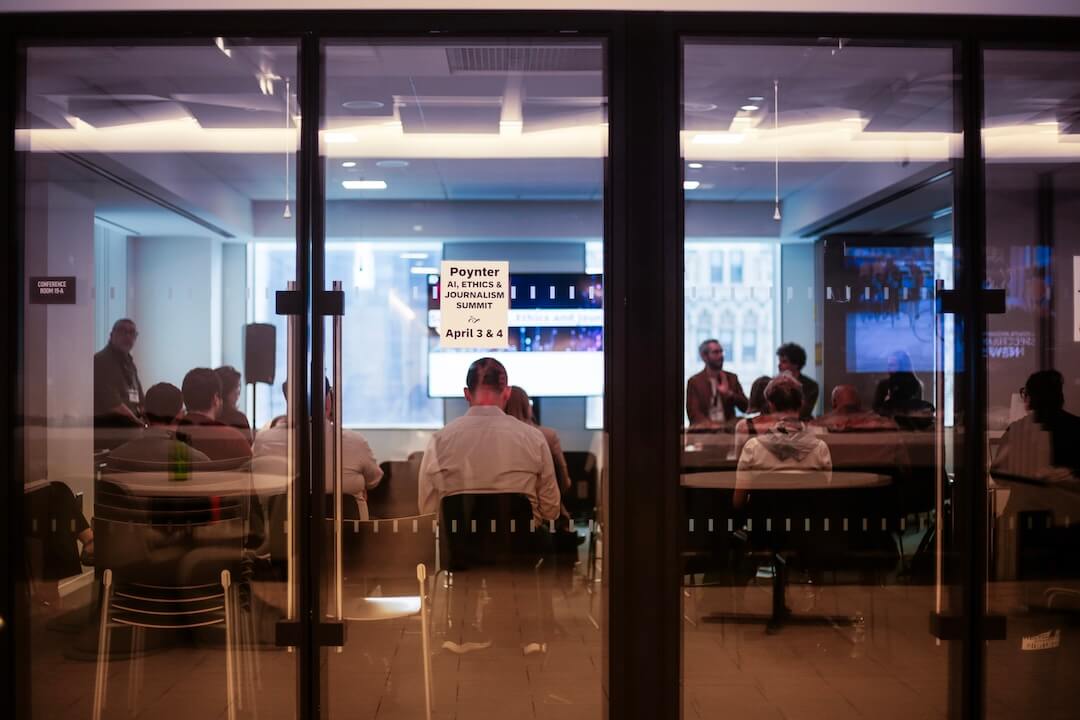This article was originally published with a different headline and lead photo on Nov. 21, 2018.
California is still burning. Millions of residents across northern California have experienced dangerously unhealthy air quality for 12 days straight, and Bay Area schools were closed last Friday because we were “in the purple” or the very unhealthy air quality range.
As I sit here writing in Oakland, our air quality index is at 165, which is in the “unhealthy” range where all populations (not only sensitive ones) may experience adverse side effects. Rain is forecast for late tonight and tomorrow, and it can’t come soon enough.

Meanwhile, in Butte County, the Camp Fire has now claimed at least 81 lives with 699 people still missing; we are almost certain to see deaths in the hundreds.
It’s the deadliest fire in California’s history, the deadliest U.S. fire in a century, and among the deadliest disasters of the 21st century.
Scrolling through my Twitter feed in the past two weeks, I’ve been disheartened by the lack of attention to the Camp Fire by most of the people I follow. I’ve also noticed that many national media outlets haven’t provided adequate coverage of this major catastrophe.
The New York Times has included photos of the devastation on its front page most of last week, but what about people who get their news either from the TV or their social media feeds? When I turn on CNN I see little in-depth coverage beyond a daily update of the numbers of dead and missing. After five minutes, Anderson Cooper and Don Lemon return to the neverending analysis and debate about Trump’s latest scandal.
It feels like deja vu, as I felt very much the same way just over a year ago during the northern California fires of October 2017, which killed 44 people. I chided Twitter followers for ignoring the death and destruction in Santa Rosa, but later deleted the tweet, second-guessing whether I was just being overly sensitive and judgmental because the fires were affecting my region of the country. Here’s what I posted on Facebook:

This fire and the resulting toxic air quality are exponentially worse than the October 2017 fires, and yet I still feel there is an East Coast bias that pervades national media outlets that prevents them from adequately covering the Camp Fire. When a hurricane threatens the southeast or Atlantic Coast, or there’s a major snowstorm, I see 24-hour news coverage on CNN.
I don’t see the same depth of coverage on California wildfires.
Last week when I noticed that Dan Rather was sounding the alarm about the Camp Fire and the lack of media attention, I became convinced that my instincts were right. He took notice early, Nov. 9, and continued posting about the Camp Fire, but his Nov. 15 tweet was dead on: “The full extent of this natural disaster hasn’t penetrated the Northeast News Bubble enough.” Later that day, he wrote: “Please America take notice of California wildfires. Dozens confirmed dead. Hundreds missing. Thousands homeless. Millions choking on toxic air. Closed schools. People wearing masks. No immediate end in sight. Oh, and please do not neglect #climatechange in your coverage.”
I also began to see other prominent voices speaking up about the lack of coverage, notably Mother Jones’ editor in chief Clara Jeffery, who in a thread Nov. 16 said, “If 1000 people were missing and presumed dead on the East Coast there’d be wall-to-wall coverage.” Of course, Mother Jones is based in San Francisco, so its staff is directly affected.
On Monday, more than 10 days after the fire began, Hillary Clinton tweeted about it, calling it not just one state’s crisis but a “national crisis.”
I’ve been tracking CNN’s coverage but have also heard that other cable news channels like MSNBC have provided similarly inadequate coverage. Instead of devoting five minutes at the top of the hour, CNN could be spending whole hours on in-depth analysis of this catastrophe.
Instead of convening their usual band of political pundits to deconstruct and (usually) mock President Trump’s latest lie, gaffe or scandal, CNN could invite on climate scientists and meteorologists to discuss not only the scope of devastation and causes of the Camp Fire but California’s increasingly bleak future in terms of wildfires and the links to climate change.
Or it could bring on experts in California politics to talk about the corporate malfeasance of the state utility company, PG&E, which was found liable for most of October 2017 fires last year. Victims of the Camp Fire have already filed a class-action lawsuit against PG&E for its alleged responsibility for this catastrophe. In short, there is no shortage of topics to discuss on national media outlets surrounding the Camp Fire.
I spoke with meteorologist Eric Holthaus, columnist at Grist, who has written about the Camp Fire extensively and been one of the most outspoken voices outside northern California about the scope of the catastrophe; he has called it a “humanitarian crisis.” He agreed with my perception of the East Coast bias of the national media.
“Every time there’s a hurricane threat it’s wall-to-wall coverage on NPR and all the news shows,” Holthaus said. “The cable shows are running 24 hours a day on the threat.”
However, he framed the issue as a larger, much more pervasive problem related to the lack of discussion about climate change. He said he views the Camp Fire as a cautionary tale that could repeat itself in any number of California cities, adding, “This disaster couldn’t have happened without climate change. Now we’re tilting the odds toward these kinds of disasters happening a lot more often.”
Holthaus noted that six of the 10 most destructive fires have happened in the past three years; he has begun to refer to this trend as a “wildfire outbreak.” He also pointed out (contradicting Trump’s glib statements) that this was not an issue of disaster preparedness — officials in Butte County had been talking about and planning for this.
“It was front of mind for a long time,” he said. “And it happened anyway.”
Local meteorologists told him that conditions were so far off the scale in the days leading up to fire that no amount of planning could have helped.
“It became an unfightable fire immediately … All that planning and all those evacuation plans and clearing the pine needles out of your gutters and all that stuff doesn’t really matter when you have climate conditions like this.”
This is why he stressed the importance of a national and ongoing conversation about the root of the problem: climate change.
When I asked whether he thought California was on the front line of climate change, Holthaus said, “Fire season is getting worse more quickly than hurricane season is getting worse.” He added that although hurricanes are more destructive in terms of property damage (because winds can be 100 miles wide), there is often a few days’ notice that allows people to evacuate.
What’s notable about both the Tubbs fire in Santa Rosa in October 2017 and the Camp Fire is the rapidity with which the fires spread; the reason they have been so deadly is because there wasn’t time to evacuate.
What ultimately came out of our conversation was the recognition of the crucial importance of local media outlets and reporters in covering catastrophes and putting a human face on destruction. The San Francisco Chronicle, Los Angeles Times, KQED (NPR’s northern California affiliate), and Chico’s own Enterprise-Record have all published or broadcast incredible, in-depth stories detailing how the fire began, who the victims of the fire are and what California can expect in the future.
What’s more, Media Matters released a report last week finding that national broadcast TV news shows mentioned the link between both the Camp and Woolsey fires and climate change in only 3.7 percent of their segments, even though researchers agree that climate change is a major factor in California’s worsening fire seasons.
Local TV news programs, on the other hand, did a much better job of discussing this link.
Notwithstanding the excellent coverage of the Camp Fire and the Bay Area’s air quality by my local news stations, I’m still dismayed when I see so few people outside of northern California talking about this catastrophe on social media. It feels unfair that although California is hardly the boondocks, our natural disasters often don’t get the attention they deserve from the East Coast-centric news media.
I was gratified, however, by the fact that the Santa Rosa Press Democrat won a Pulitzer Prize this year for its coverage of the 2017 Tubbs fire. Perhaps this is in no small part because the paper has local owners who are connected to the community it serves. I can only hope that our northern California papers will be similarly lauded for the extremely valuable work they’re doing on the ground in Butte County as we speak.
As for the national media, all I can say is, listen to Dan Rather.






